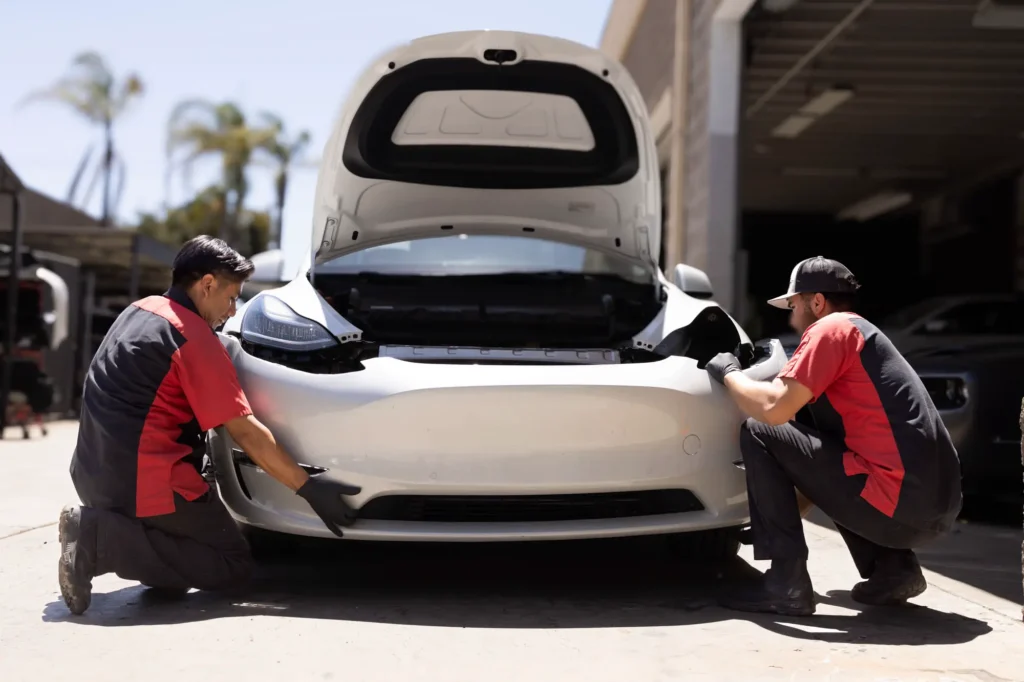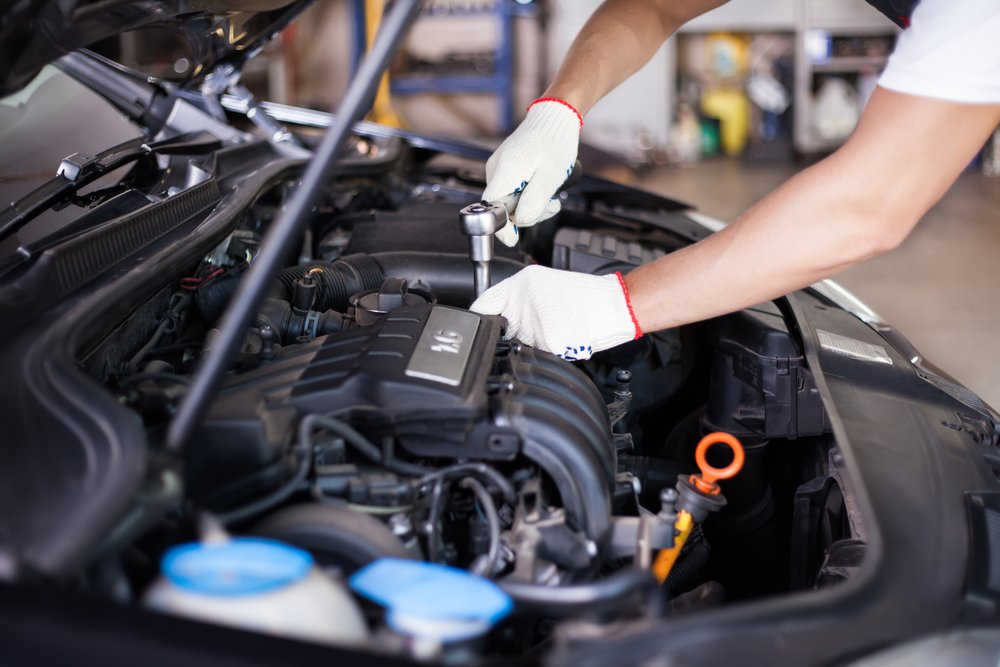Post-repair inspections are one of the most overlooked yet critical steps after getting your car fixed. You just got it back from the shop — the bumper’s smooth, the paint is gleaming, and everything seems fine. But here’s the truth: what you can’t see might cost you. That’s why every car owner should get a post-repair inspections to make sure your car isn’t just “fixed”… but truly road-ready.
Let’s break down what they are, why they matter.
What Can Post-Repair Inspections Catch?

Just because your car looks fixed doesn’t mean it is fixed. A post-repair inspection provides a comprehensive review of both visible and hidden elements of your vehicle’s condition following any type of collision repair. These inspections go beyond a visual once-over and often involve the use of diagnostic tools, measurement systems, and manufacturer guidelines to identify deficiencies. Here’s a deeper look into what a thorough post-repair inspection can uncover:
Frame or Structural Misalignment
Even a slight bend throws off alignment, handling, and crash safety. If your frame isn’t straight, your entire vehicle is compromised. According to a 2021 CCC Intelligent Solutions report, improper structural repairs account for nearly 10% of post-collision repair complaints. This is particularly concerning because a compromised structure can reduce the effectiveness of crumple zones and alter airbag timing. Inspections verify that measurements meet
Safety Features That Don’t Work
Many advanced safety features must be checked after repairs. This includes physical checks (like airbags, seatbelts, and pre-tensioners) and electronic systems. I-CAR data shows that 1 in 5 post-collision vehicles inspected by third-party shops have incomplete safety system reinstalls. Unverified repairs may leave occupants unprotected in future accidents
Sensor Recalibration Misses
Today’s cars rely heavily on ADAS (Advanced Driver Assistance Systems). Lane assist, adaptive cruise, and emergency braking rely on ADAS sensors. If they’re not recalibrated, they can malfunction or fail entirely. This happens more often than you’d think. A 2022 IIHS study revealed that 42% of vehicles with ADAS features had at least one sensor not properly recalibrated after repair. Misaligned sensors can delay or disable safety systems when they’re needed most.
Sloppy Paint or Panel Work
A rushed paint job or improperly fitted body panels can lead to more than aesthetic problems. New parts don’t guarantee function. Suspension and brake components need road testing. Sometimes, faulty installation or undetected cracks can cause future breakdowns. Poor paint work can also leave panels exposed to rust if not sealed properly. Small issues like overspray, uneven finishes, or non-aligned parts can signal larger concerns with repair quality and resale value.
Hidden Electrical Issues
Modern vehicles are loaded with complex electrical systems. Post-collision inspections can uncover issues like disconnected sensors, compromised wiring, or incorrect computer programming. AAA reports that electrical issues are among the top five reasons for post-repair breakdowns. Many of these problems aren’t visible but can be caught through diagnostic scanning.
Today’s cars are full of wiring and modules. A diagnostic scan can catch loose connections, sensor errors, or system failures before they leave you stranded.
A thorough post-repair inspection evaluates not just whether the vehicle looks okay, but whether it will perform safely and reliably in real-world driving conditions. If you’re unsure about the quality of your last repair — or just want peace of mind — it’s worth having a qualified expert take a second look. Bottom line: These aren’t just technical oversights. They’re real threats to safety, performance, and even insurance coverage. A second look could save you from a second accident.
Why It Matters More Than You Think
 A post-repair inspection does more than verify appearance. It protects your safety, your finances, and your vehicle’s long-term value.
A post-repair inspection does more than verify appearance. It protects your safety, your finances, and your vehicle’s long-term value.
1. Protect Your Safety and Prevent Further Costs
First, safety systems must work as designed. This includes ADAS sensors, airbags, and crumple zones. If any of these components are not reinstalled correctly, your car may not respond properly in a future crash.According to NHTSA, 60% of fatal front-end collisions involve vehicles with unrepaired or poorly repaired safety systems.
Additionally, over 30% of collision repair customers report returning to the shop within three months due to lingering issues. Therefore, a post-repair inspection plays a key role in identifying these problems early.By doing so, it helps you avoid future repairs, unnecessary expenses, and compromised safety.
2. Preserve Your Car’s Resale Value
n addition to safety, a post-repair inspection also helps protect your vehicle’s long-term resale value. According to CARFAX, vehicles with verified inspection reports can retain 15% more resale value. at resale.
Why? Because buyers notice poor-quality repairs.
-
Paint mismatches
-
Uneven panel gaps
-
Visible welds
These issues create doubt—even if they seem minor. More importantly, they can signal deeper problems, like missed calibrations or structural shortcuts. That is why many buyers now request pre-purchase inspections.
If your vehicle fails to meet expectations, you risk losing negotiating power—or the sale entirely.
3. Ensure Insurance and Warranty Protection
Importantly, a post-repair inspection plays a critical role in protecting both your insurance rights and vehicle warranty. In many cases, insurance companies approve an estimate and close the claim without verifying whether the repairs were done properly. As a result, if something was missed or completed incorrectly, the responsibility often shifts to you.
However, a post-repair inspection provides formal documentation that can help protect you. It can reveal:
-
Skipped OEM procedures
-
Incorrect or non-genuine parts
-
Signs of poor workmanship
With this report, you can challenge inadequate repairs or support a claim if problems arise later.
Additionally, many manufacturer warranties become void after improper repairs—especially when structural components or advanced electronics are involved. A post-repair inspection confirms that the work complies with OEM standards, which helps preserve your warranty coverage.
Ultimately, this simple but essential step helps you avoid:
-
Denied insurance claims
-
Costly repair failures
-
Disputes with repair shops or insurers
If issues appear down the road, your inspection report gives you the documentation you need to take action with confidence.
What Car Owners Should Know About Post-Repair Inspections
Even experienced car owners often overlook how much advanced technology modern collision repairs involve—or how small mistakes can cause serious long-term issues. One of the most commonly missed steps? Post-repair inspections.
1. Always Request a Post-Repair Inspection
Shops typically do not include post-repair inspections unless you ask for one. Insurance companies often approve the estimate and close the claim without checking the final repair. If the shop misses something, you may end up responsible. To avoid this, request a post-repair inspection to make sure your safety systems function properly and all structural repairs meet factory standards.
2. Watch for Skipped OEM Procedures
Many repair shops fail to follow OEM repair procedures. They may install aftermarket parts, skip essential calibrations, or take shortcuts to save time. As a result, these decisions directly impact your vehicle’s crash safety, electronic systems, and resale value.
In fact, a 2020 study by the Society of Collision Repair Specialists (SCRS) revealed that more than 70% of vehiclesinspected after repairs had at least one OEM procedure skipped—usually due to shortcuts or cost-cutting.
3. Choose a Neutral Third Party
For added protection, consider hiring an independent repair specialist or certified collision consultant to perform your post-repair inspection. A neutral expert can help you spot hidden damage and hold the original shop or insurer accountable, especially if you suspect poor-quality work.
4. Get It in Writing
In addition, a detailed inspection report—with photos or scan results—gives you documentation if problems arise later. You can use it to dispute inadequate repairs, support a warranty claim, or increase buyer confidence during resale.
5. Inspections Go Beyond Major Accidents
Even minor incidents—such as fender benders, hail damage, or windshield replacements—can affect advanced driver assistance systems (ADAS). That’s why systems like lane departure alerts and blind spot monitors often need recalibration, even when the damage appears minimal. A post-repair inspection helps you verify everything functions properly before getting back on the road.
Thinking About Applying PPF to a Freshly Painted Bumper? WAIT.
 Before you apply Paint Protection Film (PPF) to that freshly refinished bumper, make sure the paint has had time to fully cure.
Before you apply Paint Protection Film (PPF) to that freshly refinished bumper, make sure the paint has had time to fully cure.
Here’s what many people overlook:
Applying PPF too soon can trap solvents and moisture under the film. When you eventually remove it, the paint itself could peel off with it.
Paint manufacturers like BASF and PPG recommend a 30–90 day curing period for refinish paint, depending on factors like product type, weather conditions, and curing method. Installing any adhesive-backed film during this window increases the risk of finish failure.
What Should You Do?
-
Wait at least 30–60 days before applying PPF.
-
Consult your body shop or film installer about the specific paint system and environmental conditions.
-
Follow manufacturer guidelines to protect your paint investment.
Waiting a little longer up front ensures your PPF performs as intended—without damaging your brand-new finish.
Trust Premier Coach Auto Collision
 Looking for certified, precise, manufacturer-approved repairs? Trust Premier Coach Auto Collision
Looking for certified, precise, manufacturer-approved repairs? Trust Premier Coach Auto Collision
- With over 35 years of industry experience, Premier Coach delivers factory-certified repairs for top brands like Tesla, BMW, Mercedes-Benz, Lexus, and more.
- Services include Car Paint Repair, Dent Repair and Scratch Removal, Panel and Frame Repair and Collision Repair.
- Every repair follows OEM procedures to maintain your warranty and protect your vehicle’s value.
- Serving Thousand Oaks, Camarillo, and the surrounding Ventura County area.
Need a second opinion or post-repair inspection? Schedule today and let our certified technicians ensure your car is truly road-ready.
Final Thoughts: Why Post-Repair Inspections Matter
Your car might look flawless after repairs—but underneath, costly mistakes could still be hiding. Post-repair inspectionsare not just a “nice to have.” They serve as your final line of defense against poor workmanship, safety risks, and reduced resale value.
Think of it as a critical quality check—the one that confirms your vehicle is truly road-ready. Especially on modern vehicles, even a single missed calibration or shortcut can compromise your safety, warranty, or long-term performance.
Do not assume everything was done right. Do not settle for appearances alone. A post-repair inspection gives your vehicle the second look it deserves—and gives you the confidence to move forward without regret.
Need help? Contact Premier Coach Auto Collision today. Our certified experts are ready to inspect your repair and ensure everything meets the highest standards.

